{Youtube:0VmC49HvINs}
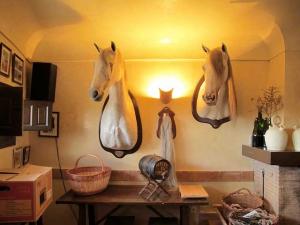 It’s the sixth annual all comers Tapas contest in Valladolid and Nick Harman has got a ringside seat. But as well as watching the three days of cook offs, he finds time to explore more of what this Spanish epicentre of small plate dining has to offer the food loving visitor.
It’s the sixth annual all comers Tapas contest in Valladolid and Nick Harman has got a ringside seat. But as well as watching the three days of cook offs, he finds time to explore more of what this Spanish epicentre of small plate dining has to offer the food loving visitor.
I don’t mind eating horse but it’s very odd being simultaneously watched by one. Both horses are stone dead but the one on the wall is very lifelike, very big and very, very stuffed.
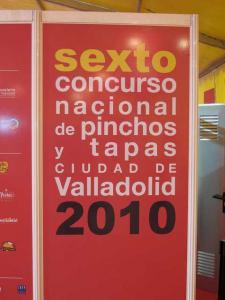 They do rather worship horses in this northern part of Spain and when the best ones die they become decoration. I’m eating Shergar in the main hall of a ranch dedicated to the ancient art of fighting bulls on horseback, as evidenced by the sepia photos lining the walls. These days bulls aren’t really harmed, the rider ‘spears’ them with the three foot equivalent of the inside of a toilet roll, but the art is the same as my host shows me later with a macho display in his own private bullring.
They do rather worship horses in this northern part of Spain and when the best ones die they become decoration. I’m eating Shergar in the main hall of a ranch dedicated to the ancient art of fighting bulls on horseback, as evidenced by the sepia photos lining the walls. These days bulls aren’t really harmed, the rider ‘spears’ them with the three foot equivalent of the inside of a toilet roll, but the art is the same as my host shows me later with a macho display in his own private bullring.
First though some lunch. As well as the finely sliced horsemeat cooked on red-hot stones at the table, we have some traditional soup. This is packed with garlic and shreds of meat and it’s very warming, which is just as well. Outside in the Rueda landscape, where some of the finest wines in Spain come from, the temperature is down to single figures and we appreciate both the soup and the roaring log fire in the grate.
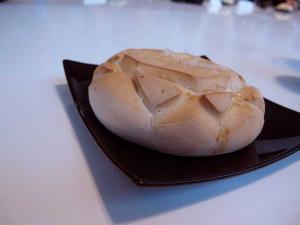 This is a break, a break from tapas, which I have been eating almost non stop since my arrival in Valladolid to attend the 2010 Sixth National Tapas and Pinchos competition. Chefs from restaurants all over Spain have already gone through a selection process in their own regions. Now, at the final stage there will be 60 chefs serving their best tapas to a demanding judging panel.
This is a break, a break from tapas, which I have been eating almost non stop since my arrival in Valladolid to attend the 2010 Sixth National Tapas and Pinchos competition. Chefs from restaurants all over Spain have already gone through a selection process in their own regions. Now, at the final stage there will be 60 chefs serving their best tapas to a demanding judging panel.
Located about one hour north of Madrid, and within three major wine-making regions: Ribera del Duero, Rueda and Cigales, Valladolid is a mixture of the modern and the old – wonderful ancient churches and palaces sit slap bang next door to ugly office blocks or in the middle of sterile car parks, a result of over zealous building programmes in the 1960’s by bright eyed planners. Many bars are also modern but the majority in the old town centre are still as they were at the beginning of the last century. As you wander from bar to bar, trying out each one’s speciality tapas as you go, you can literally taste the food heritage of this city.
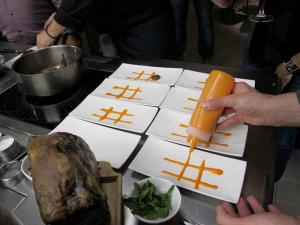 So, in between studiously attending the heats for the Tapas competition. I made sure I sampled as many of these places as possible, both traditional and modern, in an attempt to find out what makes tapas tick in 2010.
So, in between studiously attending the heats for the Tapas competition. I made sure I sampled as many of these places as possible, both traditional and modern, in an attempt to find out what makes tapas tick in 2010.
First a trip to the modern edge of town to try Restaurante Zarabanda for lunch, a place housed in an ultra trendy art centre and where chef and owner Jesus Ramiro has a Michelin star. No menu today, just a procession of new style tapas that are exciting and fun. An onion soup, so cooked down it tastes like toffee apple, has a luxurious cube of foie gras in its centre. The waitress pours a cold cream into it but I’m told not to stir just gently swirl. In the mouth cold cream and hot soup dance about magically, confusing the taste buds and the mind – one minute you’re not sure you like it, the next you love it. I mop up with the local bread, so unique in texture, shape and taste that it has its own controlled status in law so that no one can make it outside of the area.
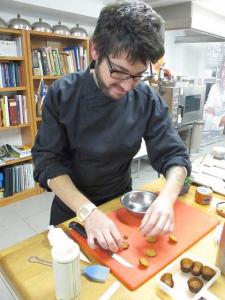 They also love saltcod in Valladolid mainly because before refrigeration it was just about the only fish they got this far inland. Jesus cooks it simply and sits it on a fluffy mound of mashed potato. Not all the salt has been soaked out of the fish but that’s surely deliberate, it reminds you of what it is and where it has come from. It’s not masquerading as fresh fish, it flaunts its status. The lunch goes on forever with dish after dish, all lubricated by Jesus’ own wine, available only in his restaurant and sourced from one of the vineyards in the area.
They also love saltcod in Valladolid mainly because before refrigeration it was just about the only fish they got this far inland. Jesus cooks it simply and sits it on a fluffy mound of mashed potato. Not all the salt has been soaked out of the fish but that’s surely deliberate, it reminds you of what it is and where it has come from. It’s not masquerading as fresh fish, it flaunts its status. The lunch goes on forever with dish after dish, all lubricated by Jesus’ own wine, available only in his restaurant and sourced from one of the vineyards in the area.
That evening I go to Jesus ‘workshop’ outside town where a team from Barandal en Leon restaurant under chef Javier Nuñez Delgado make even more dishes of Michelin quality in a quietly casual manner while I stand about watching and getting in the way. Rather like El Bulli’s workshop down south, the walls are covered in shelves of ingredient jars which emphasise the experimental and modern nature of Jesus’ cooking. Not all is modern though, to keep me happy while I wait Jesus proffers a large plate of high quality Jamon Serrano, beautifully fatty and which dissolves on the tongue. He also has a plate of cured meat, the origin of which is not clear owing to my lack of Spanish and the cooks’ lack of English. One of them assures me it’s veal, another insists it’s horse. Finally Jesus himself comes over and says it’s in fact beef. It was superb whatever it was. As his team keep creating dishes of remarkable complexity and novelty for me to try such as autumn Niscalos mushrooms with air-dried meat and an emulsion of piquilla peppers and basil, and an octopus terrine with a cream of leeks vinaigrette and crab. It’s hard to pull myself away but I have to make it to a restaurant I’ve booked for 11p.m, which is actually quite early by Spanish standards.
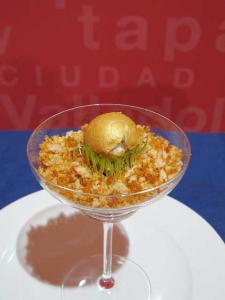 At La Perla Castilla a typical Catalan restaurant, I eat a menu designed to showcase the mushrooms the area is so rich in. Cod comes with blood sausage and cornucopioides, better known over here as Trompette de Mort, either of which sounds better than Trumpet of Death. Next cow cheek meatballs come with a Ribera wine sauce and Lactarius deliciosus, commonly known as the Saffron milk cap, a real classic Catalan favourite ‘shroom. Star of the show though is a semi-freddo made with a mixture of wild mushrooms, a coconut and marzipan sauce and layers of chocolate. It’s a mixture of flavours you might think would never work but it does so beautifully.
At La Perla Castilla a typical Catalan restaurant, I eat a menu designed to showcase the mushrooms the area is so rich in. Cod comes with blood sausage and cornucopioides, better known over here as Trompette de Mort, either of which sounds better than Trumpet of Death. Next cow cheek meatballs come with a Ribera wine sauce and Lactarius deliciosus, commonly known as the Saffron milk cap, a real classic Catalan favourite ‘shroom. Star of the show though is a semi-freddo made with a mixture of wild mushrooms, a coconut and marzipan sauce and layers of chocolate. It’s a mixture of flavours you might think would never work but it does so beautifully.
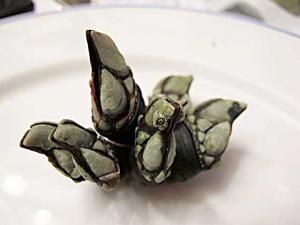 The next day I find that the otherwise excellent Hotel >Mozart offers only churros and doughnuts for breakfast. I’m resigned to a horrible sugar rush when suddenly a woman bustles in from next door with a freshly made, still hot and perfectly shaped tortilla. It would taste best lukewarm of course but even eaten hot it was delicious, a proper breakfast to tackle the day with.
The next day I find that the otherwise excellent Hotel >Mozart offers only churros and doughnuts for breakfast. I’m resigned to a horrible sugar rush when suddenly a woman bustles in from next door with a freshly made, still hot and perfectly shaped tortilla. It would taste best lukewarm of course but even eaten hot it was delicious, a proper breakfast to tackle the day with.
A visit to the competition shows that the pro finalists are cooking in heats of seven at a time. The judges are looking for a number of things; taste obviously and looks, but also, as the chairman explains to me, the tapas must be practical. ‘The essence of a tapa is that it must be available at all times the bar is open,’ he points out as we glumly watch a man wrap foie gras in gold leaf as a pastiche of Ferrero Rocher. ‘If people have to wait fifteen minutes for some elaborate creation they might as well go to a restaurant. Plus,’ he adds pointing at the gold leaf, ‘it must be profitable. Very few tapas sell for more than a couple of euros so the ingredients must be reasonable if it is to work.’ This is important as the winning tapa recipe will be given to every tapa bar in Spain and they will want to recreate it not stand bemused and annoyed by it.
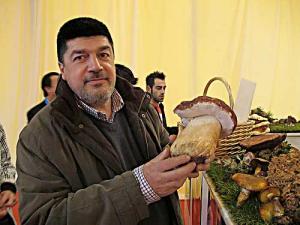 As each tapa is presented to the judges another copy is sent out to be shown to the crowds. The presentation table soon begins to resemble an art gallery of bizarre food sculptures. Do they make me hungry? Kind of. So I wander out to try some more local places.
As each tapa is presented to the judges another copy is sent out to be shown to the crowds. The presentation table soon begins to resemble an art gallery of bizarre food sculptures. Do they make me hungry? Kind of. So I wander out to try some more local places.
Don Bacalao is the Codfather. This bar and restaurant specialises in cod (bacalao) done in different ways and is a frequent award winner in Spain. The fishy and ancient decor is home to modern and traditional tapas from head chef D. Alfonso García; fresh tomatoes mashed on bread, cod simply steamed and served with home made mayonnaise and gurgling in rich olive oil, salt cod and potato popped onto bread slices and slipped under a hot grill and delicious salt cod croquettes. Garcia’s ‘Temptation’, a golden ball made of foie and smoked eel covered with almond chocolate and a shot of apple liqueur won the regional Pincho award and he is entered for the big compo too.
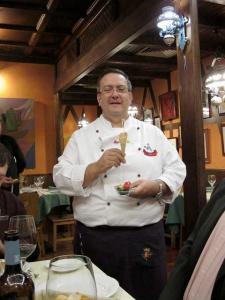 As evening draws in I leave the competition tent to warm up. Next year the competition will be in a proper building, the giant tent that is home to it this year is shaking in the icy wind and the massed TV crews are looking fearful. Before I leave I get buttonholed by a man who wants to show me his Boletus. As you can see, it’s pretty impressive.
As evening draws in I leave the competition tent to warm up. Next year the competition will be in a proper building, the giant tent that is home to it this year is shaking in the icy wind and the massed TV crews are looking fearful. Before I leave I get buttonholed by a man who wants to show me his Boletus. As you can see, it’s pretty impressive.
That night I go to Angela restaurant where the cooking is off the hook as a result of chef owner Jesús Alejos having done some time at El Bulli. A dish of tuna salad has a cornetto cone suspended above it; this is punctured at table and a rain of balsamic vinaigrette showers down over the dish as you eat so that each forkful is sprayed. Great fun. Pigeon comes in its own little ceramic house with a bowl of burning wood shavings from the forest next to it, the idea being to recreate at table the ambience of eating as the woodsmen would have done, with the aroma of the hearth fire all around you. The pigeon meat is released from the ceramic and served on a pate of pigeon offal on toasted bread.
Madness follows as piece of still smoking tree trunk appears with a prawn on top. I don’t understand why, as it’s explained in Spanish, but the prawn has foie gras sandwiched between shell and meat and is very good. I suppose that’s all that matters, the creative rationale can wait.
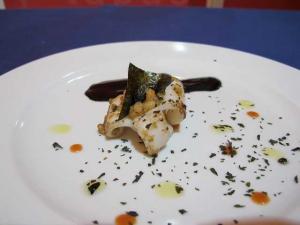 More dishes bounce and flounce onto the table, it’s a circus and it’s theatre. The dessert is powered by white wine with dry ice added, so that jets of aromatic fog surround us as we eat. Is it sensible? Probably not, but it’s experimental and shows that you can find the influences of Ferran Adria everywhere. Here, even when it sometimes it veers into Blumenthal pastiche, it’s good to see it at affordable prices and done with real panache and a wry sense of its own absurdity.
More dishes bounce and flounce onto the table, it’s a circus and it’s theatre. The dessert is powered by white wine with dry ice added, so that jets of aromatic fog surround us as we eat. Is it sensible? Probably not, but it’s experimental and shows that you can find the influences of Ferran Adria everywhere. Here, even when it sometimes it veers into Blumenthal pastiche, it’s good to see it at affordable prices and done with real panache and a wry sense of its own absurdity.
The next day, fortified by tortilla, I pop in to Los Zagalles as I’ve been told the brothers Javier and Antomio Garcia here are hot favourites in the competition and not just by the locals either. The bar/restaurant is much larger than it seems, a regular occurrence in Valladolid, but has a delicious patina of history that is apparent even at 10 a.m. and with people mopping the floors. Already though customers are standing at the bar and tucking into tapas. Jave serves me ‘Obama in the Whitehouse’ a clever dish of potato shards died black with squid ink and then fried, served on top of a soft boiled cocotte egg mixed with truffled cream of wild mushrooms and served in a white bowl.
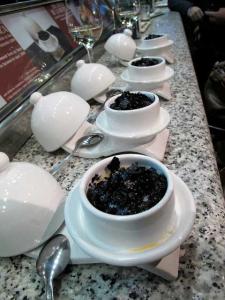 His favourite though is his actual entry for the competition, a tapa that he will be cooking live later for the judges. It’s called TigreToston. ‘It’s a little nod to our collective childhoods here in Spain,’ he explains,’ it was a sticky sweet thing which you always pestered your parents to buy in petrol stations. Of course our version is not sweet but it looks the same!’
His favourite though is his actual entry for the competition, a tapa that he will be cooking live later for the judges. It’s called TigreToston. ‘It’s a little nod to our collective childhoods here in Spain,’ he explains,’ it was a sticky sweet thing which you always pestered your parents to buy in petrol stations. Of course our version is not sweet but it looks the same!’
In fact it is sublimely tasty as I immediately find out. A slice of Rye bread is wrapped around a filling of morcilla (black pudding), caramelised red onion, powdered ‘pork scratchings’ and cream cheese and then quickly fried and placed in a packet. It’s very quick to make, only E1.50 to buy and it seems to meet all the winning requirements the head judge outlined earlier. We shall see.
A quick lunch at La Criolla where Francisco Martínez has turned a run down restaurant into a warren of rooms serving some of the finest traditional food in town. We feast on the local speciality of suckling lamb, Lechazo, roasted in a wood-fired oven and which has the best crackling I’ve ever eaten. We also have percebes, a kind of barnacle harvested by brave men who jump onto rocks hammered by death dealing Atlantic waves. They quickly grab handfuls and leap to get back onto their boat before the next wave strikes. Then they do it all again. The phrase ‘to die for’ is no joke amongst Percebe hunters.
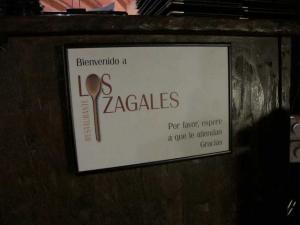 And so the competition final. The first surprise is that the student competition has been won by Ireland with a tapas ‘Irish Breakfast’. In the main event the prize for the most imaginative tapas is won by Mark Delia, originally from Sweden, who I travelled up from Madrid with and who is overjoyed.
And so the competition final. The first surprise is that the student competition has been won by Ireland with a tapas ‘Irish Breakfast’. In the main event the prize for the most imaginative tapas is won by Mark Delia, originally from Sweden, who I travelled up from Madrid with and who is overjoyed.
The big winner is Tigretoston, the local boys are overwhelmed and burst into tears in front of the TV cameras. The caterers are now sending out tsunamis of tapas, all excellent, but the brothers invite me back to theirs for the victory celebration. We eat a lot of tigretostons and it’s getting close to dawn before the crowd finally thins out and so do I.
It’s over for another year and with a full stomach and notebook it’s time to get the train back to Madrid. Valladolid is town built on tapas, fine wines and classic churches and next year I’ll be back to sample more of them all.
